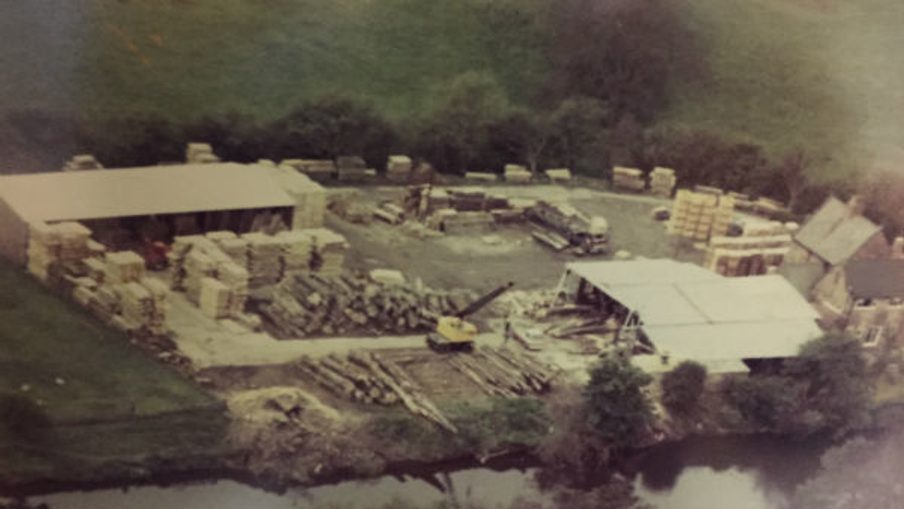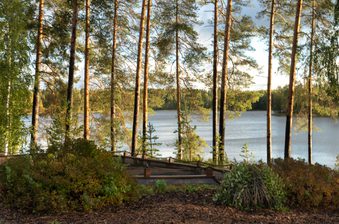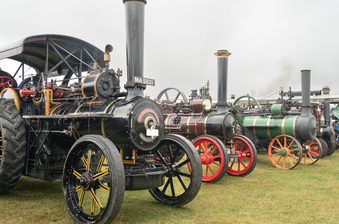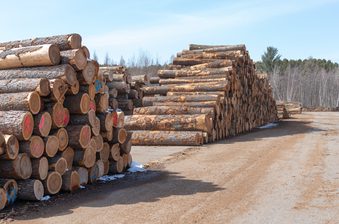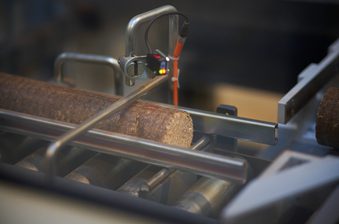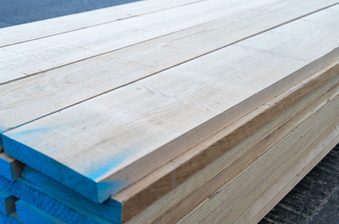Duffield Timber was founded in 1957 by Robert Duffield. Originally a small wood yard on the bank of the river Ure in Ripon, we started out selling fencing, posts and rails. Over the years, our business evolved to make pallets and potato boxes, achieving steady success.
Duffield Timber was founded in 1957 by Robert
Duffield. Originally a small wood yard on the bank of the river Ure in
Ripon, we started out selling fencing, posts and rails. Over the years,
our business evolved to make pallets and potato boxes, achieving steady
success. Major change occurred when we bought an automatic bandsaw,
allowing us to saw merchantable grade whitewoods for the chair frame
industries.
In 1979, we moved to our current site in Melmerby, Ripon. The 7 acre site soon became home, and for the past 38 years has continued to provide the perfect space for our headquarters and showroom.
Over time, we became the largest supplier of mining timber (including pit props, chocks and lids) to the Yorkshire and North East collieries. When the coal fields demised, we moved towards buying home-grown quality timbers. We installed our first kiln in order to grow this side of the business, continuing to go from strength to strength. These days, we have four kilns and a range of state-of-the-art equipment to help us provide our customers with a huge range of sawn and machined timber.
While we still stock home-grown timbers, we now also
import French and German oak boules, also supplying African and American
hardwoods. The expansion of our business from a small wood yard to a
UK-leading timber importer has been a challenging but incredibly
interesting journey, and we thank each and every one of our customers
who has supported us along the way.
The Duffield Hall of Fame
Over the past 60 years, we’ve celebrated many incredible achievements and supplied timber for a vast number of successful projects, including work with Redcar Leisure Centre.

If you’re ever in Edinburgh, make sure you look out for the Scottish Parliament building, Holyrood - we provided structural timber for the construction. This was part of a project designed by leading architect, Enric Miralles - testament, we think, to the world-class standard of timber we are able to provide.
Did you know we’re award-winning, too? In 2005, we won the Commercial & Public Access category for our work with live music venue Sage Gateshead. Building on many years of success, the year before our 60th Anniversary was a particularly important one.
A brief history of timber
Why is timber such an important material to us? This brief history of timber will hopefully let you know why we’ve been raving about timber at Duffield for the past 60 years, and will be for the foreseeable future. We like to think we know our stuff.
Timber’s properties make it a versatile, aesthetic and relatively cheap construction material - and a timeless classic. We hope this whistle-stop tour of timber’s history makes you just as curious and passionate about timber as we at Duffield are.
For thousands of years, right across the globe, timber has been an essential construction material. Most European countries have their own distinct tradition in timber construction that they proudly point to; even the Romans were pioneering the use of timber on a large scale as long ago as 50 A.D. In Britain, timber has rich and illustrious history; its use is traceable as far back as 10,000 years to the Neolithic period.
Considering the relatively contemporary concern with environmentalism, and the fact that timber is the only significant building material that is grown directly from the earth, timber has once again caught the interest of many thanks to its plentiful uses. Over the past 60 years, the modern timber industry has grown immensely. Allow us to explore a few of the key events that have helped to shape the timber trade.
In the 1950s, the modern timber industry was still in its infancy, yet beginning to take its very first steps. Timber was extracted by helicopter for the very first time in 1956, but imports were strictly controlled. The 1960s saw a dramatic increase in the number of conifer forests planted, which have come to maturity only recently. The decade saw a renaissance for timber; production rose from 20.1 million hoppus feet in 1960 to 36.5 million hoppus feet per year.
As the industry continued to expand, the ‘70s saw the disease Dutch Elm affect 30 per cent of the elm population in central and southern England. A sad day, indeed. Significant too was The Great Storm of 1987. On 15 October, massive winds measuring up to 100 mph lashed the UK, claiming 18 lives with up to 15 million trees falling down. All-in-all, it was estimated that the storms of October 1987 resulted in 50 million trees being felled - not to be sniffed at.
The 1980s saw the timber sector expand and evolve at a similar rate; noteworthy was the replacement of the Forestry Grant Scheme with the Woodland Grant Scheme. This acknowledged the importance of woods and forests as a national resource, giving support for their growth, promoting them as a crucial tool for sustainable land use. In 1992, the United Nations gave a definition of biodiversity at their ‘Convention on Biological Diversity’, concerned that ‘biological diversity is being significantly reduced by certain human activities’. This affirmed the importance of the growth of trees and the value that lies in their sustainable use.
With concerns over deforestation, you may be relieved to learn that between 1990 and 2010, the area of forest in the UK actually rose from 2.6 million to 2.8 million hectares - although perhaps this could have been even more. By the millennium, Britain had more than 12 per cent forest cover.
In 2012, over 13 million cubic metres of timber were consumed in the UK; during the International Year of Forests taking place in 2011, 41% of all the softwood timber used in the UK was grown domestically. Thanks to the right management and control, timber has proven itself capable of providing a sustainable, renewable resource - essential for the future.
As of today, forests cover approximately 31% of the globe’s total land area. For Britain’s part, by 2060, successive governments have set the aim of achieving 12% of Britain’s land area as forest. With the country now using 50 million tonnes of timber per year, there is no sign of the timber sector slowing down. These days, in the developed world, more than 70% of people live in timber frame homes - an impressive number that shows how popular timber is becoming.
With responsible management, the timber industry can continue to be a sustainable, beautiful and versatile use of planet Earth’s raw material.
Moving with the times
Starting from humble beginnings, and with a proud and pedigreed history, Duffield intends to lead the way in future of the timber industry. On our 60th anniversary, we’ve announced a £1 million investment in our sawmill facility at our home in Melmerby.
The state-of-the-art machinery provides increased speed, customisation and waste efficiency when profiling wood, forming part of our long-term aim to double turnover at the sawmill.
The additions consist of two WEINIG Powermat 1200 moulders, a Weinig Raimann Variorip and a Salvador Superpush, resulting in the sawmill being fitted with waste-optimising, laser-guided multi-rip saws as well as automatic cross-cutters with optimising and defect detection. Because of the bespoke customisations, the new machinery allows us to cater to customer demands, optimise delivery time and control costs by eliminating waste.

The new
moulders can change profile automatically within minutes, reducing
average set up time by 80–90 percent. At 12,000 RPM, the moulders have
double the power of the old machines, profiling timber 200% quicker, at a
speed of 30 metres per minute. With 8 heads, there is greater scope for
complex profiling, with the ability to provide a glass-like finish.
In addition to the new machinery, we recently unveiled our Joinery & Woodworking Centre - another example of our commitment to continue leading the way. The first of its kind, the Centre is any timber enthusiast’s dream come true.
Opened in September 2016, the Centre boasts a bonanza of rough sawn timber, including a wide range of hardwoods, squares blocks, blanks, exotic blanks and more - too many to list, in fact. The wide array of bowl blanks in Iroko, Walnut, Oak and Maple and many more are sure to leave no-one unsatisfied. That’s not all: our Centre also stocks exotics such as Jarrah Burr, Purpleheart, Pink Ivory, and Wild Olive. Such is the breadth and variety of timber on offer, an exhaustive list is simply not possible - a trip to the Centre is the only way to appreciate all that is contained there.
The Centre’s unrivalled prices, range and customer service have made it an instant hit amongst the many audiences it caters for. Whether a joiner, builder, property developer, hobbyist, wood tuner, woodcarver, carpenter or even student - indeed, anyone with a passion or interest for timber - you will find in the Centre a timber Utopia to satisfy all your arboreal needs.
Howard Duffield, Managing Director of Duffield Timber, said:
“As we look back over the past 60 years with pride at all our achievements, we’re delighted to be in the position to make such huge investments in cutting-edge technology for our facilities - mostly recently at our sawmill, but also in our new Woodworking Centre. These additions take advantage of the very latest and best on offer in the timber industry.”
“On our 60th birthday, the whole team is looking forward to continuing to provide the high-quality, cost-efficient service that we’ve built our reputation on.”
Sustainability
As timber is a natural resource, we have always taken our environmental responsibilities incredibly seriously. Timber can only be sustained if trees are continually planted - it is incumbent on the whole of the industry to act responsibly.
Over the past 60 years, we have developed our environmental policy, working in partnership with our suppliers to ensure our high standards are upheld. Our minimum standard guarantees that all purchases and vendors take into account environmental consideration. We implement this standard by ensuring all purchases and vendors are interviewed at source, where possible, including Europe and North America. We endeavour to work with vendors that are accredited with the FSC and PEFC like ourselves and have a strong environmental policy.
Our site is also equipped with a range of energy-saving solutions. We regularly review energy usage to ensure our site runs as energy efficiently as possible, considering all products and chemicals we purchase and use to minimise risk to the environment. Our offices are heated with biomass fuel and, as well as practicing what we preach, we also supply biomass fuel in the form of wood pellets and briquettes to encourage our customers to save energy too.
Our senior purchasing directors attend seminars and trade association meetings to help ensure our team are aware of any environmental issues. Energy efficiency and sustainability are quite rightly hot topics of rising interest and concern: Duffield intends to continue fulfilling its ethical responsibilities, going above and beyond to maintain its position as an environmentally considerate company.
Why timber?
Timber is a building resource not to be underestimated…
It’s all natural, so it’s safe to handle and doesn’t contain toxic chemicals.
Sustainability is an undisputed benefit of timber. It grows constantly and, with more trees being replanted each day, is an entirely replaceable source. Plus, growing trees draws carbon from the atmosphere so the making of this incredible material doesn’t harm the environment, either.
Converting tree to timber requires the lowest production energy of all popular building materials.
In terms of construction, its build-time is often quicker than other common building materials, too.
Timber is a great building resource - its malleable and versatile qualities mean it can be sculpted to the right size and shape for your vision. Timber is incredibly durable, too, and can stand natural forces and plenty of wear-and-tear. It also has fire-resistant qualities, as initial outside charing seals further damage to the interior.
It’s energy efficient - timber’s insulative qualities means it keeps the heat in during the winter and keeps the heat out during the summer - a win-win when it comes to lowering energy bills.
It’s aesthetically brilliant. With hundreds of softwoods and hardwoods available, there is always the perfect species out there to realise your vision. Timber can be used for a variety of projects, from gorgeous architecture to home furnishings. One thing’s certain: it will always look stunning.
Here’s to the next 60 years
With timber’s popularity continually growing, and with the heavy interest in renewable building resource, Duffield has absolutely no intention of slowing down!
We’re already planning to open a Cladding Centre and a Boards & Veneer Centre, hoping to replicate the fantastic success seen at our Joinery & Woodworking Centre.
While our expert team naturally keeps up to date with market trends, we are particularly interested in major industry changes and always watch out for gaps in the timber trade we can fill in, bringing the latest and best to our existing and potential customers.
No-one’s perfect (but we like to think we come pretty close!) - there are always developments in processes and new discoveries that will help us deliver only the best quality timber. We pride ourselves on stocking unbeatable timber, and don’t intend on letting these world-class standards drop over the next 60 years.

Sources
http://www.invest-timber.com/timber-investments/871/uk-timber-industry-booming-as-conifers-mature
https://www.woodlandtrust.org.uk/mediafile/100229275/stake-of-uk-forest-report.pdf?cb=58d97f320c
https://en.wikipedia.org/wiki/Forestry_in_the_United_Kingdom
https://www.woodlandtrust.org.uk/mediafile/100229275/stake-of-uk-forest-report.pdf?cb=58d97f320c
http://www.internationaltimber.com/news/timber/history-of-timber-framing
https://www.homebuilding.co.uk/advantages-of-timber-frame-buildings/
